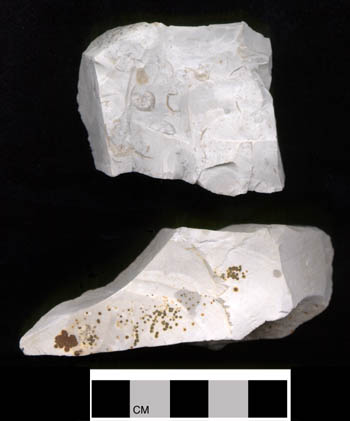Elwood - Joliet Chert
© 2003 by the Center For Social Research, Parkland College
Use the "back" button on your browser screen to return to the previous page.
Note that there is a general overlap between Elwood-Joliet, Burlington, and Glacial Till chert in all five of the classificatory properties. Correct assignment of small items of debitage to these types must remain somewhat problematic.
TEXTURE:
The texture is medium to fine.
LUSTER:
Luster tends to be dull.
COLOR:
Color ranges from white to gray.
FOSSILS:
Fossil inclusions are sponge spicules, brachiopods, bryozoans, corals, and crinoid columnals. Brachiopods will be quite common in Elwood as suggested in the illustrated specimen. Halysites or chain coral fossils (a link to the images of the Kentucky Paleontological Society) are considered definitive of Elwood by Ferguson and Warren (1992:30). Unfortunately they may be rather uncommon or not present in a small item of debitage. Note the presence of what is likely Halysites in the top, center of the illustrated specimen of Elwood.
STRUCTURAL CHARACTERISTICS:
A distinctive structural inclusion in both chert varieties is small iron pyrite ("fool's gold") crystals (Ferguson and Warren 1992:10-11). Note their presence on and in the Joliet specimen. Joliet will also contain relatively large (greater than 5 mm) inclusions of druse and limestone. Under 15X magnification, an entire viewing area will appear "sugary." Lastly, there will be small voids (Ferguson and Warren 1992:12).
HEAT TREATMENT:
The color and luster effects of thermal alteration are not known.
SOURCE:
The illustrated specimens were generously provided by Jacquelin Ferguson and Robert Warren of the Illinois State Museum. Both the Elwood (top) and Joliet (bottom) were recovered from the Joliet National Quarry, Will County, Illinois.
 The top illustration is Elwood and the bottom illustration is Joliet.
The top illustration is Elwood and the bottom illustration is Joliet.
Click on image for full view.

